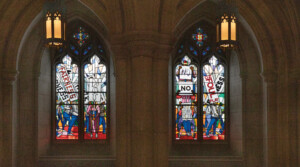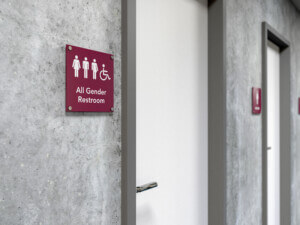In the late summer of 1967, the civil rights movement was coming to a head. While it manifested around numerous issues throughout the country, in Milwaukee the fight for fair housing would be the catalyst for marches and protest that would last for months. Led by an unlikely advisor, Father James E. Groppi, son of Italian immigrants, and the NAACP Youth Council, thousands turned out for months of consecutive marches.
In early 1967, the State of Wisconsin passed its first open housing law to prohibit discrimination in the sale, rental, and financing of housing. While the law was considered a step in the right direction, loopholes involving owner-occupied multifamily properties meant most of Milwaukee’s housing was not included in the law. African Americans, living almost exclusively on the North Side of the city, were not able to move or buy property anywhere else in town.
The division of the city was embodied in the 16th Street Viaduct, locally known as “Milwaukee’s Mason-Dixon line.” The bridge still stretches from the predominantly African American neighborhoods of the North Side to the predominantly white, mostly Polish, South Side.
When Father Groppi and the NAACP Youth Council gathered to protest the city’s refusal to pass its own, stricter, fair housing ordinance, 16th Street would become a symbol of their struggle. The first march across the viaduct took place on August 28, 1967. About 200 demonstrators walked from the North Side to Kosciuszko Park on the South Side. There they met an overwhelming 5,000 hostile counter-protestors. The next night, marching again, 13,000 counter-protesters hurled rocks, bottles, and fireworks at the civil rights marchers. Acting to protect the marchers were the Youth Council Commandos, young men who would create human walls to shield the women and children participating from the angry South Siders and the increasingly brutal police force. Undeterred, the marches would continue for 200 consecutive nights, through Milwaukee’s frigid winter.
Just weeks after the end of the marches, Martin Luther King Jr. was assassinated in Memphis, Tennessee, on April 4, 1968. Notably, before taking up the fight in Milwaukee, Father Groppi had marched alongside King in Selma, Alabama, in 1965. In the days following King’s death, tens of thousands filled the streets of Milwaukee to mourn. By April 11, President Lyndon Johnson signed the Civil Rights Act of 1968, also known as the Fair Housing Act. Milwaukee would go on to pass even more stringent regulations later that year.
Fifty years on, the city of Milwaukee is still reflecting on the events of that fateful era. The 16th Street viaduct has been renamed after Father Groppi, but the city is still considered one of the most segregated in the country. The lines dividing African Americans from whites have shifted, but are still staggeringly apparent. While the larger conversation about housing today is focused on affordability and sustainability, it is worth remembering that the simple act of wanting to live where you want is a battle that has been going on for decades.










